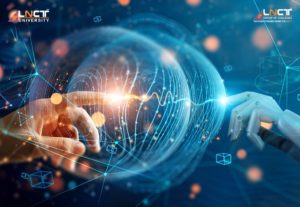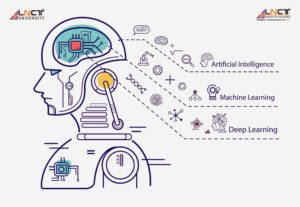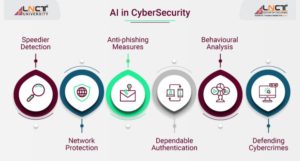Index
- Introduction
- The Evolution of Cyber Threats: Unraveling the Digital Menace
- Understanding Artificial Intelligence in Cybersecurity: Navigating the Digital Frontier
- Applications of AI in Cybersecurity – Empowering Humans in the Fight Against Digital Threats
- Challenges and Limitations of AI in Cybersecurity – Navigating the Path to Effective Defense
- Conclusion
Introduction
As technology continues to advance, so do the tactics employed by cybercriminals. In this perpetual cat-and-mouse game, the realm of cybersecurity demands innovative solutions that can stay one step ahead of malicious actors. In the battle of safeguarding our digital lives, a powerful ally has emerged: Artificial Intelligence (AI). Enter Artificial Intelligence (AI), a transformative force that holds immense potential for bolstering digital defense.
Artificial Intelligence (AI), a branch of computer science dedicated to developing intelligent machines that can replicate human thought processes, has emerged as a transformative force in the field of cybersecurity. AI plays a crucial role in cybersecurity by identifying patterns, handling large volumes of data, and making quick decisions. It has transformed how organizations safeguard their digital assets. By harnessing AI in cybersecurity, both businesses, and individuals can strengthen their defenses and take proactive measures against emerging threats.
The union of Artificial Intelligence and cybersecurity brings numerous benefits to the table. First and foremost, AI can drastically improve the speed and accuracy of threat detection. Traditional security systems often struggle to keep up with the sheer volume and complexity of cyber threats. However, AI-powered systems can quickly analyze massive datasets, identify anomalies, and detect potential breaches in real time. This proactive approach enables organizations to respond swiftly and mitigate risks before they escalate into full-blown attacks.
Moreover, AI algorithms can adapt and learn from evolving threats, continuously refining their detection capabilities. By analyzing historical data and identifying trends, AI systems can predict potential attack vectors and generate early warnings. This predictive intelligence empowers security teams to proactively fortify their defenses and stay one step ahead of cybercriminals.
However, what truly sets AI apart in cybersecurity is its potential to augment human capabilities and create a symbiotic partnership between humans and machines. Rather, it serves as a force multiplier, amplifying the efforts of cybersecurity professionals. By automating routine tasks, such as threat monitoring and incident response, AI frees up valuable time for human analysts to focus on more complex and strategic aspects of cybersecurity. This human-machine collaboration combines the best of both worlds, allowing organizations to leverage AI’s computational power while benefiting from the human ability to reason, contextualize, and make nuanced decisions.
While the benefits of AI in cybersecurity are undeniable, it is crucial to strike a balance between automation and human intervention. Ethical considerations, privacy concerns, and potential biases within AI algorithms must be carefully addressed to ensure the responsible and transparent use of this technology. Implementing AI in cybersecurity requires a holistic approach that combines technical expertise, robust governance frameworks, and ongoing human oversight.
In this blog, we delve into the realm of AI in cybersecurity, exploring the myriad ways this transformative technology is revolutionizing digital defense. We will discuss cutting-edge AI applications, industry trends, and the potential challenges and opportunities that lie ahead. Join us on this journey as we explore how AI can enhance cybersecurity in a human way, ensuring a safer and more secure digital future for all.
The Evolution of Cyber Threats: Unraveling the Digital Menace
As technology continues to advance at an unprecedented pace, so do the tactics and sophistication of cyber threats. To navigate this treacherous terrain, we must understand the human aspect behind these evolving dangers and explore how Artificial Intelligence (AI) can help us in our ongoing struggle for digital security.
In the early days of the internet, cyber threats were often simplistic and driven by individual hackers seeking notoriety or mischief. These were the digital pioneers, exploiting vulnerabilities in computer systems for personal gain or simply to test their skills. As society became increasingly reliant on interconnected technologies, the threat landscape expanded, giving rise to more organized and financially motivated cybercriminal groups.
Over time, cyber threats have become a global epidemic, with attacks spanning various industries and targeting both individuals and large organizations. The motivations behind these attacks have evolved, encompassing financial gain, political espionage, activism, and even warfare. The perpetrators range from skilled individuals to state-sponsored actors, each employing ever more sophisticated techniques to achieve their nefarious goals.
The exponential growth of data and interconnectivity has provided cybercriminals with a vast playground to exploit. Malware, phishing attacks, ransomware, and social engineering tactics have become prevalent weapons in their arsenal. As the nature of threats has become increasingly intricate, our methods of protecting our digital assets have also evolved to match the complexity.
This is where AI steps into the fray. Artificial Intelligence has become a powerful partner in our battle against cybercrime, thanks to its capacity to imitate human thinking and process enormous volumes of data. By leveraging the capabilities of AI, we can elevate our own skills and reinforce our defensive measures in ways that were previously inconceivable.
AI empowers us to swiftly and precisely identify and counter threats, surpassing the levels of speed and accuracy we could achieve before. Machine learning algorithms can analyze vast datasets, recognize patterns, and identify anomalies that may indicate a potential attack. With real-time monitoring and predictive analytics, AI systems can proactively identify and neutralize threats before they cause significant damage. This symbiotic partnership between humans and machines allows us to combine our ingenuity and contextual understanding with the computational power and efficiency of Artificial Intelligence.
However, we must remember that AI is not a panacea. Cybersecurity is a multidimensional challenge that requires a comprehensive and holistic approach. While Artificial Intelligence can significantly enhance our defenses, it is not a substitute for human expertise and intuition. Human intervention is vital to interpret AI-generated insights, contextualize threat intelligence, and make critical decisions that go beyond the realm of algorithms. Furthermore, the ethical implications of AI in cybersecurity must be carefully considered, ensuring transparency, fairness, and accountability in its implementation.
As the digital landscape continues to evolve, so will the tactics employed by cybercriminals. The rapid advancement of technologies such as the Internet of Things (IoT), cloud computing, and artificial intelligence itself presents both opportunities and challenges. We must remain vigilant, adapt to emerging threats, and continue to innovate in our pursuit of digital security.
In this journey, AI serves as a powerful tool in our arsenal. By embracing AI in a human way, we can leverage its computational capabilities while retaining the human touch. Together, humans and machines can rise above the ever-evolving cyber threats, securing our digital future and safeguarding the interconnected world we rely on.
Understanding Artificial Intelligence in Cybersecurity: Navigating the Digital Frontier
With our dependence on digital platforms for communication, financial activities, and the storage of personal data, safeguarding our information from malicious individuals becomes of utmost importance. In this ongoing battle, Artificial Intelligence (AI) emerges as a powerful ally, offering innovative solutions to bolster our defenses. But what exactly is AI, and how does it shape the landscape of cybersecurity in a human way?
In the realm of cybersecurity, AI plays a pivotal role in augmenting our digital defense mechanisms. AI technologies such as Machine Learning, Computer Vision, and Natural Language Processing work together to enhance our ability to identify and tackle cyber threats more effectively.
A notable advantage of AI is its proficiency in swiftly processing and analyzing massive volumes of data. In contrast, conventional cybersecurity systems often face difficulties in keeping pace with the sheer magnitude and intricacy of present-day threats. However, AI-powered algorithms can swiftly sift through mountains of data, recognizing patterns, and detecting anomalies that may indicate an ongoing or imminent attack. This enables us to respond in real-time, taking proactive measures to safeguard our digital assets.
AI algorithms are continuously learning and evolving, adapting to the ever-changing landscape of cyber threats. By analyzing historical data, AI systems can identify trends, anticipate potential vulnerabilities, and generate insights to fortify our defenses. This predictive intelligence allows us to stay one step ahead of cybercriminals, anticipating their tactics and devising robust countermeasures.
However, Artificial Intelligence (AI) in cybersecurity is not here to replace human knowledge and expertise anytime soon but it’s about enhancing it. The human element remains critical in interpreting the insights generated by AI systems, contextualizing the information, and making informed decisions. AI serves as a force multiplier, empowering cybersecurity professionals to focus on more strategic and complex tasks by automating routine processes such as threat monitoring and incident response. By combining the strengths of humans and machines, we create a partnership that harnesses the computational capabilities of AI alongside the intuitive, creative, and ethical decision-making abilities of humans.
However, AI also poses its own challenges and hurdles that we need to acknowledge and address. Ethical considerations, transparency, and biases within AI algorithms are areas that demand careful attention. Responsible implementation of AI in cybersecurity requires a comprehensive framework that ensures fairness, accountability, and privacy protection. It is our responsibility as humans to guide and oversee AI systems, ensuring they align with our values and serve the greater good.
As we navigate the digital frontier, understanding AI in cybersecurity is crucial to safeguarding our digital lives. It is a transformative technology that empowers us to combat ever-evolving threats in a more efficient and effective manner. By embracing AI in a human way, we can leverage its immense potential while upholding our values and principles. With Artificial Intelligence (AI) in cybersecurity, we can ensure that our digital environments are safe and secure paving the way for a future that is both safer, more secure, and more protected.
Applications of Artificial Intelligence in Cybersecurity: Empowering Humans in the Fight Against Digital Threats
In today’s rapidly growing digital world, where the dangers of cyber threats are significant and our personal data is constantly vulnerable, the demand for strong cybersecurity measures is more crucial than ever. To tackle the ever-changing landscape of these threats, Artificial Intelligence (AI) has emerged as a transformative technology, granting us the power to safeguard our digital belongings with improved efficiency and effectiveness. Let’s explore some of the human-centric applications of AI in cybersecurity and how they enhance our defense against digital adversaries.
- Threat Detection and Prevention: AI has revolutionized threat detection by harnessing its ability to analyze massive volumes of data in real-time. By leveraging machine learning algorithms, AI systems can identify patterns, anomalies, and indicators of compromise that may go unnoticed by traditional security measures. This allows us to detect and prevent potential cyber-attacks before they cause substantial damage, safeguarding our sensitive information.
- Behavioral Analysis: Understanding the behavior of users and systems is a crucial aspect of cybersecurity. AI can analyze user behavior, network traffic, and system logs to establish baselines and identify deviations that may signify malicious activity. By continuously learning from data, AI algorithms can detect anomalies, flag suspicious behavior and enable prompt intervention.
- Malware Detection and Mitigation: Malware poses a significant threat to our digital infrastructure. AI-powered antivirus software can employ machine learning techniques to identify and classify malware based on its characteristics and behavior. This proactive approach enables us to stay ahead of new and emerging malware strains, protecting our devices and networks from compromise.
- Phishing and Social Engineering Defense: Phishing attacks exploit human vulnerabilities through deceptive emails, messages, or websites. AI algorithms can analyze content, language, and sender characteristics to identify phishing attempts with high accuracy. By detecting and flagging suspicious communications, AI helps us avoid falling victim to scams and protects our personal and financial information.
- Vulnerability Management: Identifying vulnerabilities in software and systems is crucial for effective cybersecurity. Artificial Intelligence can automate the scanning and analysis of code, network configurations, and system logs to pinpoint weaknesses. This enables us to prioritize and patch vulnerabilities promptly, reducing the risk of exploitation by attackers.
- Incident Response and Forensics: When a security incident occurs, a swift and efficient response is essential. AI can aid in automating incident response workflows, enabling faster containment and remediation. Additionally, AI-powered forensic analysis can assist in investigating and attributing cyberattacks, providing valuable insights to enhance future defenses.
- User Authentication and Access Control: Artificial Intelligence plays a vital role in strengthening user authentication and access control mechanisms. By analyzing user behavior, biometric data, and contextual information, AI algorithms can detect anomalies that may indicate unauthorized access attempts. This helps prevent account compromise and strengthens the overall security posture.
While AI offers immense potential in cybersecurity, it is essential to maintain a human-centric approach. Human expertise and oversight are crucial in interpreting AI-generated insights, validating results, and making informed decisions. Ethical considerations, transparency, and bias mitigation should be central to AI implementation to ensure fair and responsible use of this technology.
In the ever-evolving battle against cyber threats, AI serves as a powerful ally, enhancing our ability to detect, prevent, and respond to attacks. By embracing Artificial Intelligence applications in cybersecurity, we empower ourselves to navigate the digital landscape with greater confidence and resilience. Together, humans and machines can forge a more secure future, where our digital assets are safeguarded, and our privacy and trust are protected.
Challenges and Limitations of AI in Cybersecurity: Navigating the Path to Effective Defense
Artificial Intelligence (AI) has emerged as a transformative force in the realm of cybersecurity, empowering us to combat the ever-evolving digital threats with greater efficiency. However, while AI offers immense potential, it is important to acknowledge the challenges and limitations that come hand in hand with its implementation. Let’s explore these human-centric aspects and navigate the path to an effective defense.
- Adversarial Attacks: Cybercriminals are not sitting idle; they constantly adapt their tactics to circumvent security measures. Adversarial attacks involve deliberately manipulating AI systems to exploit their vulnerabilities. By feeding manipulated data or altering algorithms, attackers can trick AI systems into making incorrect decisions or evading detection. Addressing these sophisticated attacks requires ongoing research, robust defenses, and human vigilance.
- Limited Understanding of Context: AI systems excel at pattern recognition and analysis, but they often lack contextual understanding. They may misinterpret or misclassify certain situations, leading to false positives or false negatives. Contextual knowledge, intuition, and human judgment remain essential in interpreting AI-generated insights and making informed decisions.
- Data Quality and Bias: Artificial Intelligence relies heavily on data for training and decision-making. If the data used to train AI models is incomplete, biased, or of poor quality, it can affect the accuracy and reliability of the AI system. Biases present in training data can lead to discriminatory outcomes or overlook certain threats. Ensuring diverse, representative, and high-quality data is crucial for minimizing biases and enhancing the effectiveness of AI in cybersecurity.
- Explainability and Transparency: AI algorithms often operate as black boxes, making it challenging to understand the rationale behind their decisions. In cybersecurity, explainability is crucial for understanding how Artificial Intelligence systems identify and classify threats. Transparent AI models and interpretability techniques are necessary to gain insights into the reasoning behind AI-generated outputs, enabling human experts to validate and trust the results.
- Ethical and Privacy Considerations: The implementation of AI in cybersecurity raises ethical concerns and privacy considerations. Artificial Intelligence systems may process vast amounts of personal data, raising questions about data protection, consent, and privacy violations. Ensuring ethical use, proper governance and adherence to legal frameworks are essential for maintaining trust and respect for privacy.
- Overreliance and Human Expertise: While AI enhances cybersecurity, it should not replace human expertise. Relying solely on AI without human oversight can lead to complacency, overlooking unique threats and attack vectors. Cybersecurity professionals bring critical thinking, creativity, and contextual understanding to the table, collaborating with AI to strengthen defense capabilities.
- Constant Evolution and Adaptation: Cyber threats evolve rapidly, and Artificial Intelligence systems must keep pace with emerging attack techniques. Maintaining AI models and algorithms requires continuous updates, retraining, and staying up-to-date with the latest threats. Organizations need to invest in ongoing research, development, and skilled cybersecurity professionals to ensure that Artificial Intelligence remains effective in the face of evolving challenges.
By acknowledging these challenges and limitations, we can chart a path toward maximizing the benefits of AI in cybersecurity while mitigating potential risks. Balancing the power of AI with human expertise, responsible governance, and continuous innovation will empower us to navigate the complex and ever-changing cybersecurity landscape in a way that protects our digital assets, preserves privacy, and fosters trust in the digital world.
Conclusion: Embracing the Power of Artificial Intelligence in Cybersecurity
The role of Artificial Intelligence (AI) in cybersecurity is undeniable. AI offers unprecedented potential to enhance our defenses, detect emerging threats, and fortify our digital landscapes. However, as we harness the power of AI, we must remember that human ingenuity and collaboration remain vital to navigate the challenges and limitations associated with this technology.
AI, when applied in a human-centric manner, can significantly augment our capabilities in the fight against cyber threats.
However, we must tread carefully and address the challenges and limitations that come with AI implementation. Adversarial attacks, limited contextual understanding, biases in data, and the need for explainability and transparency are crucial considerations. Respecting privacy, ensuring ethical use, and maintaining a balance between AI and human expertise are essential for responsible and effective AI in cybersecurity.
As we move forward, we must foster a collaborative ecosystem that combines cutting-edge technology with human capabilities. Ongoing research, investment in skilled professionals, and a commitment to ethical frameworks will shape the future of Artificial Intelligence in cybersecurity. By humanly embracing the power of Artificial Intelligence, we can build a safer digital world, protecting our personal information, critical infrastructure, and societal well-being.
Ultimately, it is through the convergence of human intellect and AI-driven technology that we can face the ever-evolving landscape of cyber threats with confidence and resilience. By leveraging Artificial Intelligence as a powerful tool while upholding our human values, we can pave the way for a future where security, trust, and innovation thrive in harmony.





